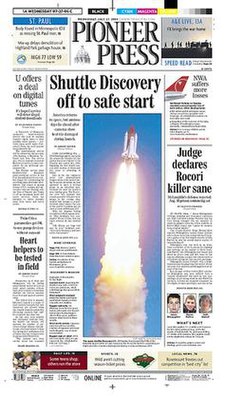St. Paul Pioneer Press
 The July 27, 2005 front page of the Pioneer Press | |
| Type | Daily newspaper |
|---|---|
| Format | Broadsheet |
| Owner(s) | MediaNews Group |
| Editor | Mike Burbach |
| Founded | 1849 |
| Headquarters | 10 River Park Plaza, 7th Floor St. Paul, Minnesota 55101 |
| Circulation | 208,280 Daily 284,507 Sunday (March 2013)[1] |
| ISSN | 0892-1083 |
| Website | twincities.com |
The St. Paul Pioneer Press is a newspaper based in St. Paul, Minnesota, primarily serving the Twin Cities metropolitan area. Circulation is heaviest in the eastern metro region, including Ramsey, Dakota, and Washington counties, along with western Wisconsin, eastern Minnesota and Anoka County, Minnesota. The paper's main rival is the Star Tribune, based in neighboring Minneapolis. The Pioneer Press has been owned by MediaNews Group since April 2006.
History

The Pioneer Press traces its history to both the Minnesota Pioneer, Minnesota's first daily newspaper (founded in 1849 by James M. Goodhue), and the Saint Paul Dispatch (launched in 1868). Ridder Publications acquired the Pioneer and the Dispatch in 1927. Ridder merged with Knight Publications to form Knight Ridder in 1974. The two papers were operated for many years as separate morning and evening papers, but in 1985 were merged into the all-day publication the St. Paul Pioneer Press and Dispatch, which made the transition to a morning-only paper in 1990, when the words "and Dispatch" were dropped. The paper is sometimes called the "Pi Press", just as "Strib" is used for the Star Tribune.
From 1947 to 1949, the newspaper printed the comic strip Li'l Folks, by Twin Cities native Charles M. Schulz. This comic introduced a number of characters who would later return in 1950 in the syndicated comic strip Peanuts, including Charlie Brown and a dog strongly resembling Snoopy.
In 1952, the Dispatch began sponsoring a treasure hunt as part of the Saint Paul Winter Carnival. Clues to finding a medallion are printed in the paper, and the first person to find and return it with the clues and a registered carnival button wins a sum of money. The prize started off at $1,000 and as of 2004 rose to $10,000.
The paper has won three Pulitzer Prizes: in 1986, 1988, and 2000.
On March 10, 1999, the day before the University of Minnesota men's basketball team was to begin play in the NCAA Tournament, the Pioneer Press published a story written by George Dohrmann with allegations that a staffer wrote coursework for many Minnesota basketball players within the past five years.[2] Immediately, Minnesota suspended four players suspected of academic fraud, and in 2000, the NCAA vacated all postseason appearances by Minnesota from 1994 to 1998 and docked scholarships for four years, among other penalties.[3] Dohrmann would win a Pulitzer Prize for beat reporting in 2000 for his reports on the scandal.[4] Dohrmann and his editor prepared for hostile reactions to the newspaper from the local community.[5] Minnesota governor Jesse Ventura accused the Pioneer Press of timing the article to be published around NCAA Tournament time for the sake of "sensationalism journalism," and the Pioneer Press got many hostile calls and letters in response to the story.[6]
The McClatchy Company acquired the paper in June 2006 when it bought Knight Ridder. As owner of the Star Tribune, McClatchy had to sell the Pioneer Press because of antitrust concerns.[7] The Pioneer Press was subsequently sold by McClatchy to MediaNews Group later in the year.
Notable journalists
- Joseph H. Ball, who was a columnist for the Pioneer Press before becoming a Republican U.S. Senator for Minnesota
- Jim Caple
- Nick Coleman
- George Dohrmann, winner of the 2000 Pulitzer Prize for beat reporting, for stories about the University of Minnesota basketball scandal.
- Dick Gordon
- Herb Greenberg
- Mark Kellogg, the first Associated Press correspondent to die in the line of duty when he was killed at the Battle of the Little Bighorn.
- Katherine Lanpher, columnist and later co-host of The Al Franken Show
- James Lileks
- Jim Romenesko, Internet reporter for the Pioneer Press from 1996 to 1999, now blogger at JimRomenesko.com
- John Sandford/John Camp, author of the "Prey" series of crime novels and winner of the 1986 Pulitzer Prize for Feature Writing.
- Bob Sansevere, sports columnist and member of the KQRS-FM morning show with Tom Barnard.
- Joe Soucheray, general columnist and host of the KSTP afternoon program, Garage Logic.
- Charley Walters, sports columnist
- Jacqui Banaszynski, writer, editor and winner of the 1988 Pulitzer Prize for Feature Writing.
- Bruce Orwall, writer and current editor at The Wall Street Journal.
- Deborah Howell, executive editor and vice president who died in 2010.
Gallery
-
James. M. Goodhue
-
1908 US editorial cartoon on Theodore Roosevelt and conservation
See also
References
- ^ "Total Circ for US Newspapers". Alliance for Audited Media. March 31, 2013. Retrieved June 18, 2013.
- ^ Dohrmann, George (March 10, 1999). "U basketball program accused of academic fraud". St. Paul Pioneer Press. Archived from the original on December 30, 2001. Retrieved May 13, 2007.
- ^ Drape, Joe (October 25, 2000). "COLLEGE BASKETBALL; Minnesota Penalized by N.C.A.A." New York Times. Retrieved June 25, 2014.
- ^ "The 2000 Pulitzer Prize Winners, Beat Reporting Citation". Pulitzer Prizes. Retrieved June 25, 2014.
- ^ Overholser, Geneva (2003). "Minnesota's basketball cheating scandal". Project for Excellence in Journalism. Archived from the original on January 24, 2003.
- ^ Robertson, Lori (May 1999). "Body slam". American Journalism Review. Retrieved June 25, 2014.
- ^ [1] Archived 2006-05-26 at the Wayback Machine


